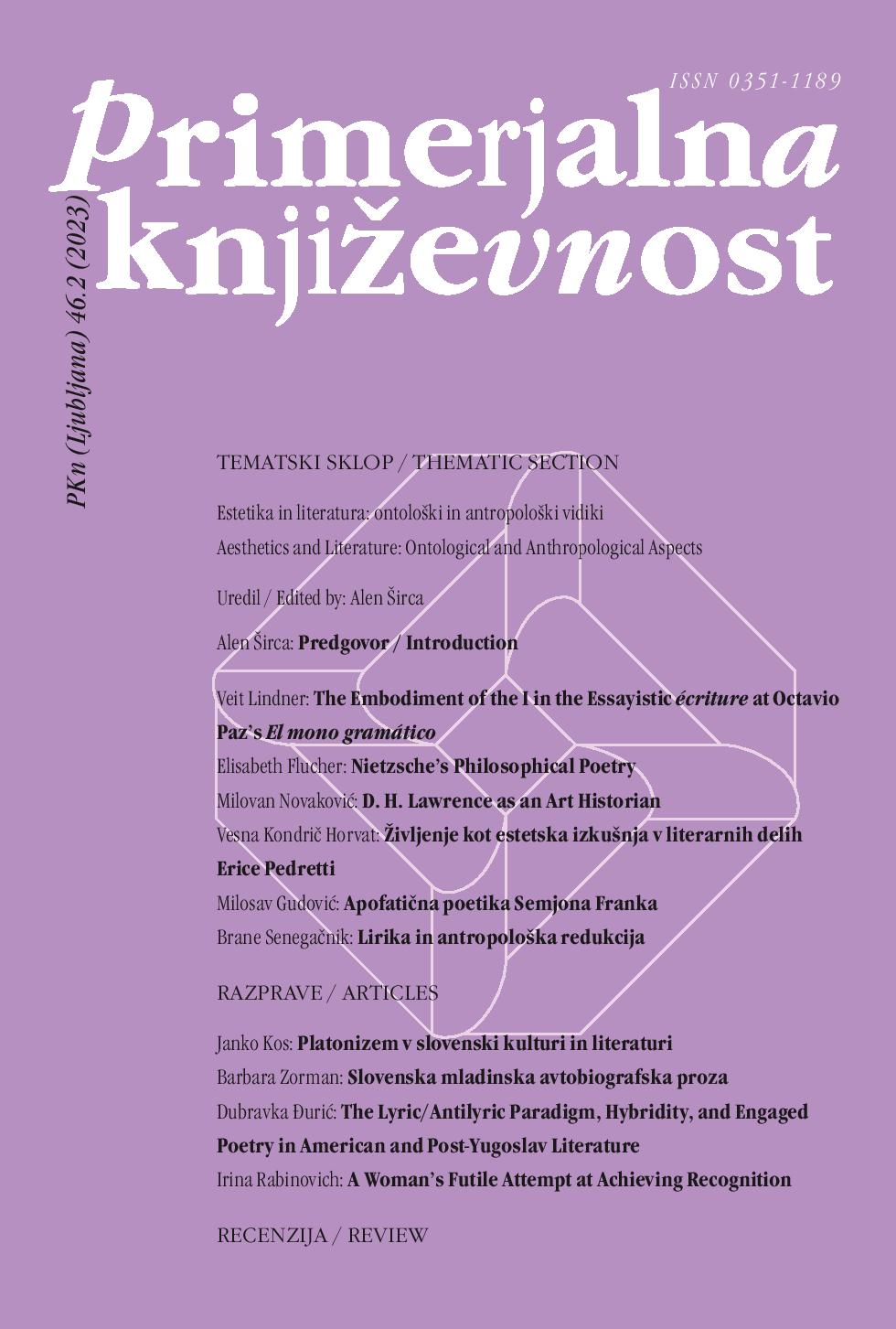Painting and Ontology: D. H. Lawrence as an Art Historian
DOI:
https://doi.org/10.3986/pkn.v46.i2.03Keywords:
philosophy of culture, literature and painting, English literature, D. H. Lawrence, ontological polarity, Cézanne, Paul, Riegl, Alois, Wölfflin, HeinrichAbstract
More than any other twentieth-century writer, D. H. Lawrence developed a profound understanding of painting and evaluated this art form through the prism of his idiosyncratic ontological scheme. In allegiance to his polaristic philosophy, in which everything is created by the opposition of static and dynamic, mind and body, optical and tactile, “Will-to-Motion” and “Will-to- Inertia,” light and darkness, Lawrence conceived the history of visual arts as a mirror of this universal opposition of ultimate metaphysical forces. Despite his general view that Western art was entirely under the dominion of idea, mind, and light, Lawrence pointed to several examples in which dark, bodily, and haptic experiences were processed pictorially. This essay intends to introduce Lawrence as an art historian who understood works of art and art historical periods as constituted out of a never-ending power struggle between the corporeal and the spiritual, and who always sought and called for their reconciliation and balance in his literature.
References
Badt, Kurt. The Art of Cézanne. Berkeley, CA: University of California Press, 1965.
Doran, Michel, ed. Conversations with Cézanne. Berkeley, CA: University of California Press, 2001.
Hauser, Arnold. The Social History of Art IV: Naturalism, Impressionism, the Film Age. New York, NY: Routledge, 2014.
Jonas, Hans. The Phenomenon of Life: Toward a Philosophical Biology. New York, NY: A Delta Book, 1966.
Lawrence, D. H. Apocalypse and the Writings on Revelation. London: Penguin Books, 1995.
Lawrence, D. H. Late Essays and Articles. Cambridge: Cambridge University Press, 2004.
Lawrence, D. H. Letters I. Cambridge: Cambridge University Press, 1979.
Lawrence, D. H. Letters II. Cambridge: Cambridge University Press, 1981.
Lawrence, D. H. Letters V. Cambridge: Cambridge University Press, 1989.
Lawrence, D. H. Letters VI. Cambridge: Cambridge University Press, 1991.
Lawrence, D. H. Psychology and Unconscious and Fantasia of the Unconsciousness. Cambridge: Cambridge University Press, 2014.
Lawrence, D. H. Reflections on the Death of a Porcupine and Other Essays. Cambridge: Cambridge University Press, 1988.
Lawrence, D. H. Sketches of Etruscan Places and Other Italian Essays. Cambridge: Cambridge University Press, 1992.
Lawrence, D. H. Sons and Lovers. Cambridge: Cambridge University Press, 1992.
Lawrence, D. H. Study of Thomas Hardy and Other Essays. London: Grafton Books, 1986.
Lawrence, D. H. The Complete Poems. London: Penguin Books, 1993.
Lawrence, D. H. Women in Love. Cambridge: Cambridge University Press, 1987.
Nehls, Edward, ed. D. H. Lawrence: A Composite Biography Vol. III, 1925–1930. Madison, WI: The University of Wisconsin Press, 1977.
Riegl, Alois. “Late Roman or Oriental?” German Essays on Art History. Ed. Gert Schiff. New York, NY: Continuum, 1988. 173–190.
Riegl, Alois. Gesammelte Aufsätze. Augsburg: Benno Filser Verlag, 1928.
Shiff, Richard. “Water and Lipstick: De Kooning in Transition.” Willem de Kooning: Paintings. Ed. Marla Prather. New Haven, CN: Yale University Press, 1994. 33–73.
Sloterdijk, Peter. Aesthetic Imperative: Writings on Art. Cambridge: Polity Press, 2017.
Wölfflin, Heinrich. Principles of Art History: The Problem of the Development of Style in Later Art. New York, NY: Dover Publications, 1950.


